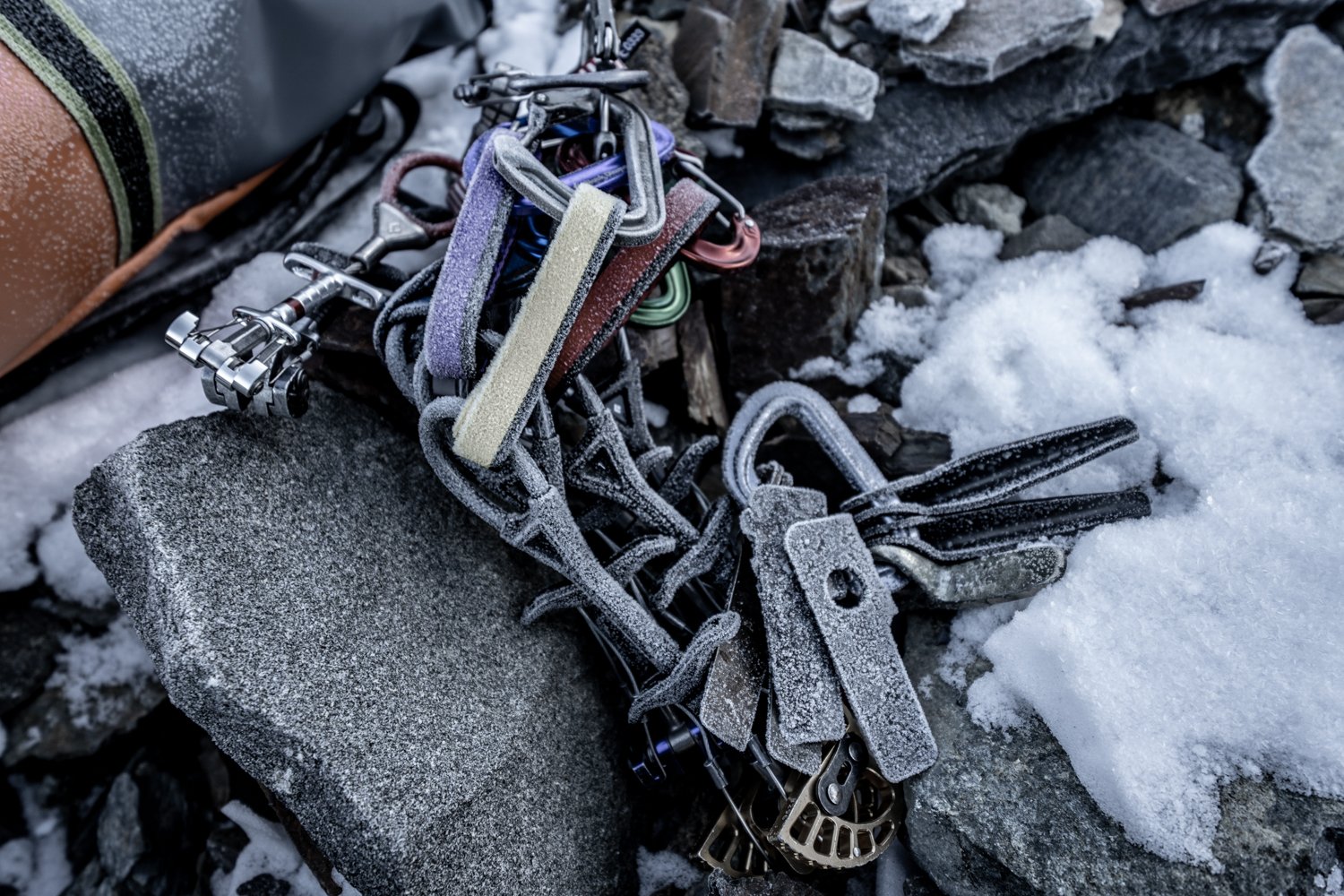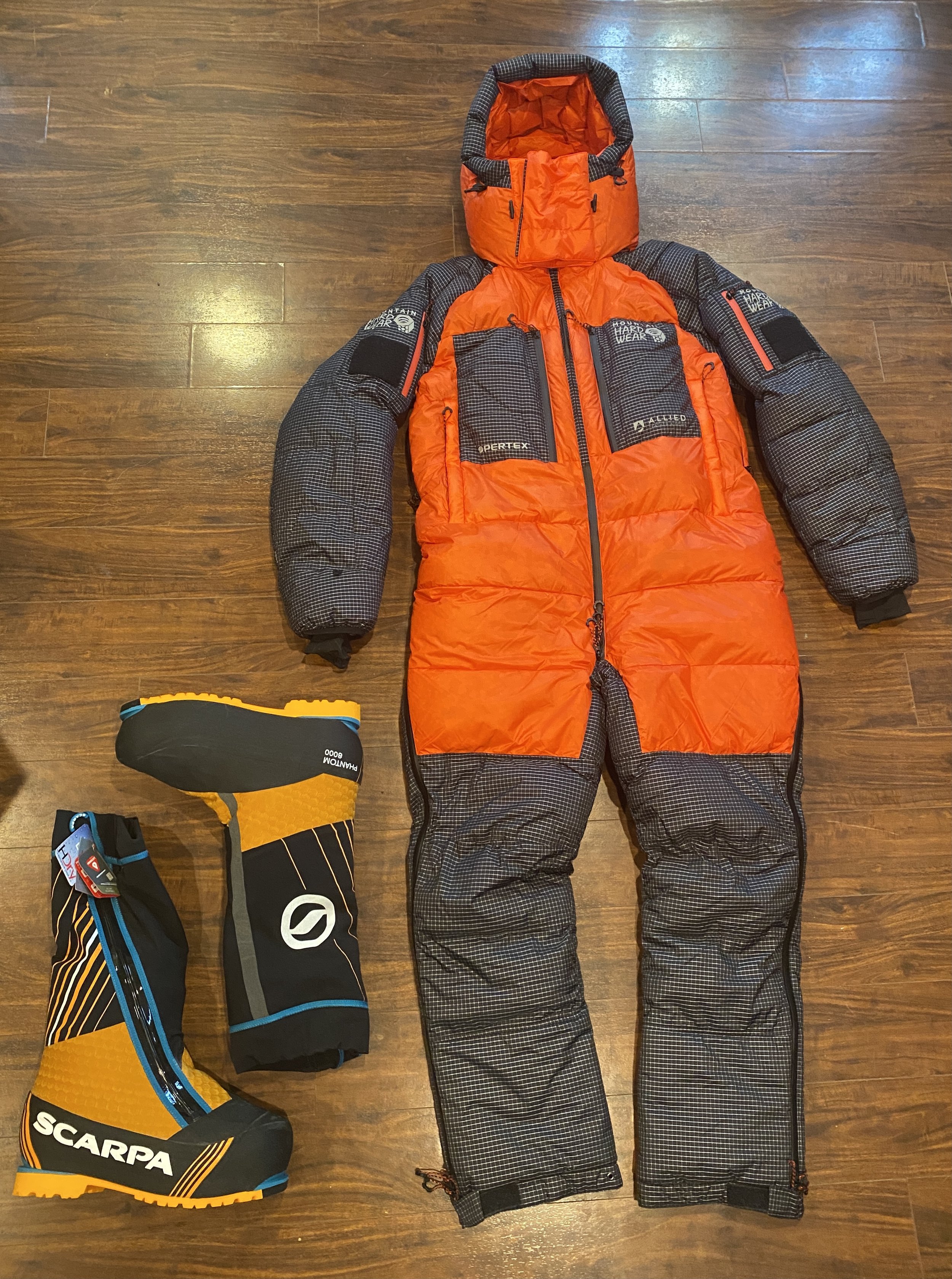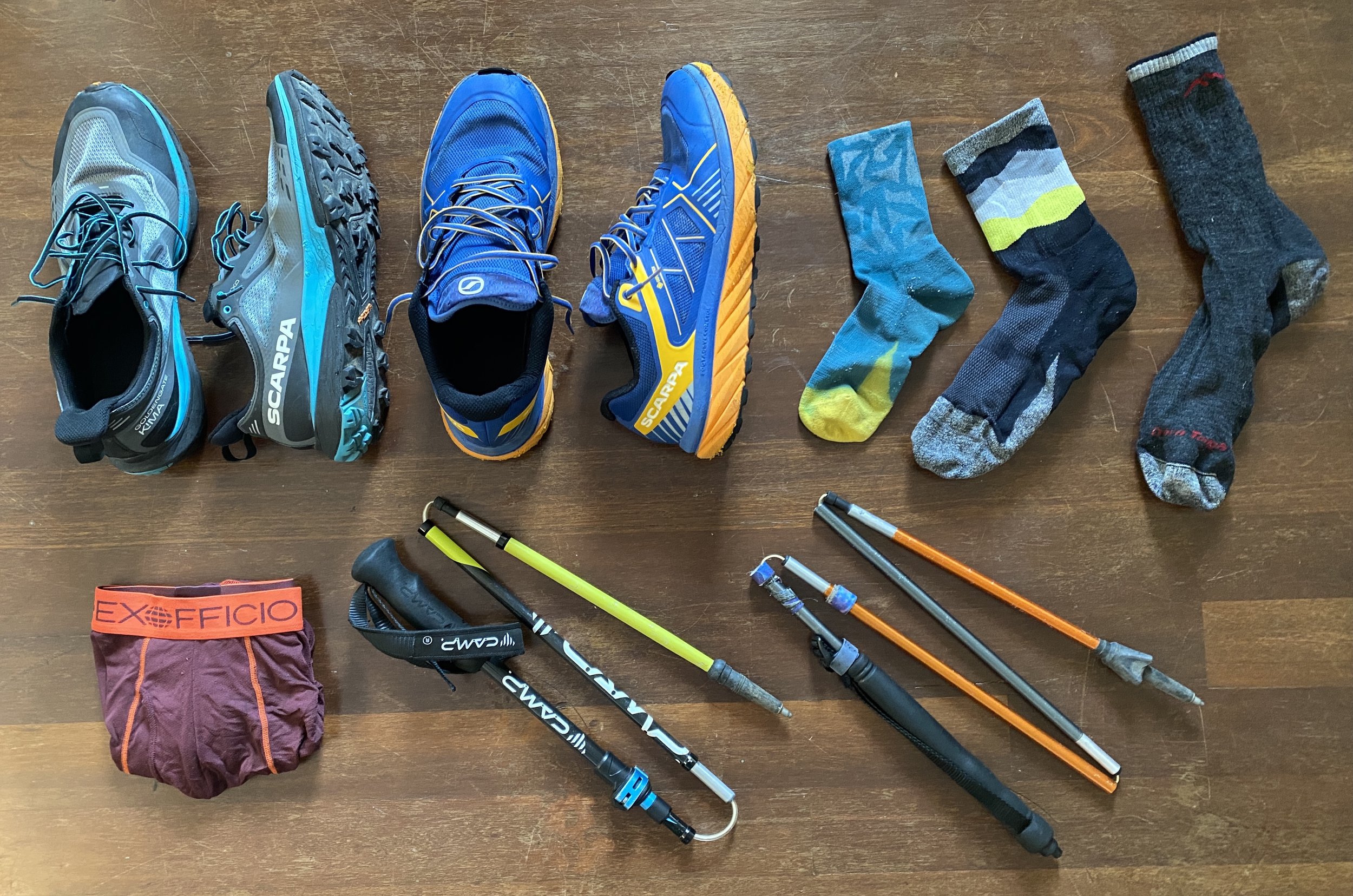
Manaslu (8,163m / 26,781ft) via Standard NE Route
Guiding a group of 6, September 2022.
Location: Manaslu Conservation Zone (NW of Kathmandu).
Manaslu is known as “Mountain of the Spirit.” It is the 8th highest mountain in the world and certainly holds a prominent energy. This year on Manaslu, conditions were absolutely terrible. Due to this, we did not put anyone on the summit as I felt it would have been unsafe to do so on a guided trip. The monsoon was long and ran late, thus on the mountain it snowed almost every day and in basecamp it was heavy rain. This is common for the mountain but conditions this year were very unsafe and unfortunately a handful of people lost their lives, all in separate avalanche accidents. I was expedition leader for SummitClimb and I had 6 clients, 4 Sherpa, and 3 basecamp staff. Our team was safe and sound throughout the trip and we had no accidents.
Nature of route: Moraine to wet snow. Glaciated mountaineering. Very low technical difficulties. Mostly walking with short technical ice steps. Fixed ropes throughout.
Temperatures (Guessing) between 0F and 40F
Long 11-12 hour nights.
Extremely wet. Rain in basecamp, heavy snow on mountain.
Busy mountain. Many teams on route each day.
Ama Dablam (6,812m / 22,360ft) via SW Ridge
Summit on November 19.
Location: Sagarmatha National Park (Khumbu Region).
Ama Dablam is one of the Crown Jewels of the Himalaya and is extremely popular. It is a beautiful mountain from far away and on it’s classic southwest ridge. It is a must-do for anyone climbing in the Khumbu, even if you don't like fixed ropes. The route features beautiful rock, easy mixed terrain (70 degrees or so), a knife-edge snow arete, narrow-ridge camps, and a high lofty summit just south of Everest.
Temperatures between 0F and 45F
Windchill to -20F
Long 12 hour nights.
Very dry. Sunny every day. But windy up high!
Busy mountain. Many teams on route each day.
Kit Synopsis
With Manaslu being very wet and the Khumbu being very dry, the experiences with equipment were very different from each other. At Manaslu, I relied heavily on synthetic jackets and an umbrella! In the Khumbu- trekking and climbing Ama Dablam + Lobuche East, I didn’t even carry a rain jacket! For hardware, I was on fixed rope routes this trip so I didn't have to carry any sort of rack and opted for lightweight items in my crampons and ice axe.
Manaslu viewed from SE. Main summit is on the Left.
Morning time at Camp 1 (5,600m).
On the summit of Ama Dablam!
Tenji Sherpa at first light at 6,600m on Ama Dablam.
Tenji Sherpa and I at the Yellow Tower below Camp 2 on Ama Dablam.
Emily and I at Kala Patthar, Everest behind.

At Altitude
At higher altitudes, the lack of available oxygen impacts the body’s ability to regulate temperature. Thus the outside temperature & the wind feel a bit colder than normal. Here are my two most important pieces:
Absolute Zero Down Suit // Mountain Hardwear
The Absolute Zero Down Suit by Mountain Hardwear is a best-in-class and fully featured solution to arctic temperatures, wind, and staying warm at altitude. The suit weighs 4.3 pounds and features Pertex 20D Diamond Fuse Ripstop shell fabric on the torso (Orange) and Pertex® 50D reinforced panels at elbows, knees, seat, and hem (Black). The suit is filled with 800-fill RDS-certified down in a box-wall construction (meaning the inner wall and outer wall are not actually touching each other as in stitch-through construction). It is easy to go to the bathroom, to vent, and to access items inside the many pockets.
Phantom 8000 Boot // SCARPA
Our hands, feet, and face are most vulnerable for frostbite in the cold and wind. It is much easier to manage our hands and face throughout the day than our feet. SCARPA’s Phantom 8000 is the answer to storing your foot in a safe and highly mobile boot throughout your time on the mountain. Some of the key features of the boot other than it’s climbing ability are: 8-layer liner with Primaloft® 600, Wintherm® and Aerogel®. 6-layer shell construction with Microtech, Wintherm® and cork. The boot is full-auto and semi-auto crampon compatible and comfortable for many days in a row.
Clothing by Mountain Hardwear
Left to Right: Mountain Stretch LS + Crater Lake SS. PowerGrid Hoody, Kor AirShell Warm Jacket.
Left to Right: Ghost Whisperer UL. Nilas Jacket.
Quasar Lite Gore-Tex Active Jacket.
Left to Right: Chockstone Alpine Pant. Compressor Pant.
Base Layer: Men’s Crater Lake Short Sleeve
Base Layer: Men's Mountain Stretch™ Long Sleeve
Base Layer: Men's AirMesh™ Long Sleeve Crew
Light Puffy: Men's Kor AirShell™ Warm Jacket
Light Puffy: Men's Ghost Whisperer™ UL Hoody
Light Hardshell: Men’s Quasar Lite™ GORE-TEX Active Jacket
Down Parka: Men's Nilas™ Jacket
Softshell Pant: Men's Chockstone™ Alpine Pant
Puffy Pant: Men’s Compressor Pant
Clothing Overview: I have been relying on this layering system, in general, all year. In Alaska & Peru I fell in love with the Koa AirShell Warm Jacket. This is a hard-wearing, well-fitting, highly mobile climbing jacket built to endure the many things that happen during an expedition. It can be worn every moment of the trip and relied on heavily. Of all the layers this is the one I most recommend. Secondly I am huge fan of the Ghost Whisperer UL. Weighing in at just 6.67 ounces- its hard to imagine a better jacket to stash away in your backpack in case you need it. For reference a Patagonia Houdini Windbreaker is 3.7 ounces. So for just 3 ounces more you can have an entire insulated jacket with 1000 fill power Down! Can’t beat that. Third, I would recommend the Nilas Jacket. This robust Parka is built for expeditions in cold environments and can handle changing conditions very well. The outer face fabric is AirShield 15D 2-layer Ripstop which can handle any surface you might brush up against as well as heavy winds encountered at high altitude on a Himalayan Peak. I much prefer a synthetic pant since we spend a lot of time sitting on snow or scratchy rocks, if the pants do rip, it’s no problem and if they get wet they will certainly dry easily.
Hands + Packs
Gloves: Approach Liner top left, Geko Ice top right, Geko Hot bottom left, Exposure/2 bottom right.
Primary Climbing Glove: CAMP Geko Hot Glove
Secondary Climbing Glove: CAMP Geko Ice Glove
Warmer Gloves: Mountain Hardwear Unisex Exposure/2 Gore-Tex Glove
Approach Glove: Mountain Hardwear Unisex Power Stretch® Stimulus™ Glove
Summit Mitts: Unisex Absolute Zero™ Gore-Tex® Down Mitt
Climbing Pack: Mountain Hardwear Alpine Light™ 35
Climbing Pack: Mountain Hardwear Alpine Light™ 50
Getting frostbite on my fingers is a major concern of mine that luckily has never happened. I prefer to bring more gloves than normal if it means avoiding this. During a summit push, I usually keep 1-2 extra pairs of gloves inside my jacket against my chest so they are pre-heated should I need to put them on. I also stuff a hand warmer inside every glove before leaving the tent. I find the CAMP ice climbing gloves to be very impressive. They are very durable, warm, and have an amazing fit. The dexterity is perfect for me when climbing or working with hardware. Of all their models, in the high mountains I like the Geko Hot & Geko Ice the most. Above those, I usually bring my Exposure/2 Gore-Tex Glove by Mountain Hardwear. This is a classic but well-engineered big-mountain glove offering full protection in the mountains. Most importantly, I carry summits with me. These oversized down mitts are popular in the Himalayas. Often there are other people around and you won’t be going very fast- not having a pair of big mitts might cost you your fingers. The Absolute Zero Gore-Tex Down Mitt is the best one I know of.
For backpacks, I’ve been using the Alpine Light line from Mountain Hardwear all year. On this trip I had a smaller one (I use this trekking) and a bigger one (for on the mountain). These packs are very light and still come with all the features I like. Some of those are: Removable brain (50L only), easy to open and close, removable zippered-bag that sits inside the main body, hip belt pockets, and crampon straps on the front. The packs are made with Nylon-Spectra and you can expect them to withstand many expeditions and days out at the crag.
Hardware by CAMP
Crampons: CAMP XLC Nanotech Automatic
Crampons: CAMP Alpinist Pro
Ice Tool: CAMP X-Light
Ice Axe: CAMP Corsa Nanotech
Helmet: CAMP Storm
Harness: CAMP Alpine Flash
Belay Device: CAMP PIÙ 2.0
Ascender: CAMP Turbohand Pro
V-Threader: CAMP Scorpio
Locking Carabiner: (2) CAMP Photon Lock
Locking Carabiner: (2) CAMP Nitro Lock
Two Alpine Draws: CAMP Nano 22 Carabiners, 60cm Dyneema Sling
Two Ice Screws: CAMP Rocket 16cm +19cm
Extras: (2) Nano 22 w/ 120cm Dyneema Sling, Ice Clippers, CAMP Dyon Carabiner w/ 60cm Dyneema Sling
Crampon Bag: CAMP Crampon Carrying Case
15 feet of cord
On this trip to Nepal working as a guide, I was on fixed-rope routes. This is very different from the kind of climbing I normally do, especially in Alaska, and it requires a very different arrangement of equipment. Fortunately it means we don’t carry much hardware so that is nice. By using equipment from CAMP, you can expect to have a lighter arrangement of hardware than anyone else on the mountain. This was my first trip using the Corsa Nanotech ice axe. While acclimatizing in the thin air- weight matters and it weighs only 7.9 ounces for the 50cm. The main piece of equipment we use on fixed-rope routes is a jumar. Arranging a special piece of cord with locking carabiners on two ends (see bottom of photo) is key to being organized on the mountain. I see a lot of people using dyneema slings, which get all twisted up on themselves and because they are static, they may break if you shock load them. I brought two pairs of crampons and used the XLC Nanotechs on everything except Ama Dablam. On Ama Dablam, you are constantly scratching on rocks and I was happy to have a fully robust crampon like the Alpinist Pro which can more than perform in that kind of terrain.
Accessory Kit
SCARPA 5-Panel Trail Hat
Garmin 66i inReach (Not Pictured)
Petzl Swift RL Headlamp (Not pictured)
(2) Petzl Bindi Headlamp
(2) 1 Liter Nalgenes w/ insulated sleeve (Not Pictured)
Pulse Oximeter
Cozy Beanie from Alaska
Various Snacks!
Garmin Instinct Solar Watch (Not Pictured)
Dermatone SPF 30 Sunscreen Stick
Goggles
Med Kit
Extras: Front bar replacement for Alpinist Pro Crampons, Hand warmers, Chapstick, Athletic tape, Bic lighters, battery pack, Strepsils, Buff.
This is a general photo showing some of the smaller items I carry during an expedition. Of course there are many little things, such a snacks & water, that are not pictured but this gives an idea of what’s in my “accessory bag.” I am beginning to favor the Bindi headlamps. They weigh nearly nothing and by carrying 2, you get the best of both worlds: an extra battery and an extra bulb. This trip I had the SCARPA 5-Panel Trail Hat, it is the perfect cap for an expedition as its flexible construction makes it pack easy, fit under a helmet comfortably, and of course it excels on the trail. I plan to bring this hat on future trips as well. The OuterU Face Glove is kind of like your “Oh Shit!” piece. If the wind is really blowing and your nose/cheeks are getting blasted, frostbite can happen easily and this will protect you from that. I recommend buying on. It weighs nothing and means everything.
Eyewear // Julbo Ultimate Cover
On this trip I was fortunate to have a pair of these incredible sunglasses. The Ultimate Cover Sunglasses do exactly what they say they will: Push the Summits. These ultralight performance shades come with removable side shields and a nose guard. Most importantly, the lens I had is their Reactiv tech which adjusts to changing light levels around you and on these frames it’s a single lens spanning across both eyes providing a wide range of vision. All day comfort was the part- they can be comfortably worn all day on trail or with a helmet on during a climb. I’m looking forward to wearing these on expeditions around the world in 2023.
Trek & Travel.
Trek Kit:
Trail Shoes: SCARPA Spin Infinity GTX Men’s
Shorts: Men’s Shade Lite Short
Trekking Poles: CAMP Sky Carbon Evo
Trekking Poles: CAMP Xenon Pro 2.0
Trail Socks: Feetures Elite Ultra Light Mini Crew
Mountain Socks: Darn Tough
Underwear: ExOfficio Men's Give-N-Go 2.0 Sport Mesh 6'' Boxer Brief
Travel Kit:
Travel Shoes: SCARPA Golden Gate Kima RT Men’s
Shades: Julbo Fuse
Bottom: Men's Basin Pull-On Pant
Pack: Redeye 45 Travel Pack
I prefer to be lightweight on the trail. My favorite trekking poles have become the two CAMP options listed above. I’ve taken a particular liking to the Xenon Pro 2.0 this trip. When trekking every day for a month at a time, I prefer handles that are not ergonomic, rather just lightly featured foam on the straight shaft of the pole. Poles need to be able to fold up nicely for transport in and out of helicopters, to be stored away during technical terrain, and to travel to and from your home far away.
For footwear, I brought two pairs and ultimately used the SCARPA Spin Infinity GTX throughout the trip. At home I wear the SCARPA Golden Gate Kima RT for local hiking and training and prefer it. On the long dusty and sometimes muddy trails of the Himalaya I liked the Spin Infinity GTX for two reasons: The Gore-Tex membrane keeps the feet dry and thus protected throughout changing trails. And secondly, the heavy cushion below the foot is perfect for keeping your feet feeling healthy and strong throughout the long trip.
Lastly, socks & underwear comfort & durability are of huge importance on expedition, especially ones that involve a lot of trekking. I’ve found lately that my feet have the best results in the Feetures socks. And for several weeks of comfort in underwear, there is absolutely no better option than ExOfficio. I’ve been wearing this model of underwear on expedition for 4-5 years and have never had problems.
Tents, Duffels, & Sleep Systems:
Top to Bottom: Phantom Alpine, Phantom 0, Lamina.
Top to Bottom: AC2, ACI3, Trango 3.
Top to Bottom: Camp 4 135L, Expedition 100L, Expedition 140L.
Light Sleeping Bag: Phantom Alpine 15F
Go-To Sleeping Bag: Phantom 0F Gore-Tex
Heavy Sleeping Bag: Lamina™ -20F/-29C
Tents: Trango 3, ACI™ 3 Tent, AC 2.
Duffels: Expedition 140, Expedition 100, Camp 4 135L
The Mountain Hardwear options for sleeping bags, tents, and duffels are best in class- no question. All products are made with the highest level of materials available and are backed by nearly 30 years of in-house design process that yield expedition equipment truly built for the mountains. Having a nice quiver of options for sleeping bags and tents is very handy on expedition. While climbing alpine style, the choices would be for lightweight products, examples: Phantom Alpine 15F & AC2. For guiding on a big peak with fixed ropes, the weight is acceptable and the extra protection & comfort that comes with it is welcomed, examples: Trango 3 tent & Phantom 0F Gore-Tex. I have the Lamina -20F for basecamp luxury and I can bring it to high camp if I’m concerned about temps. A great middle ground for weight to strength ratio in tents is the ACI3. This magnificent tent resembles a double-wall structure in many ways but is only a single wall, resulting in a low weight. It has a fantastic venting system and does not accumulate much condensation overnight if vented properly. The Expedition Duffel line is perfect for the Himalayas where bags are strapped to Yaks or carried by porters and they get ample wear during the trip. These bags are full-feature equipment movers that can be strapped to the top of a jeep on a bumpy road, the side of a yak, left high in a mountain camp, and sent on an airplane. The Camp 4 Duffel is ideal for travel. It folds into it’s own side pocket and can be moved around easily when empty.





















